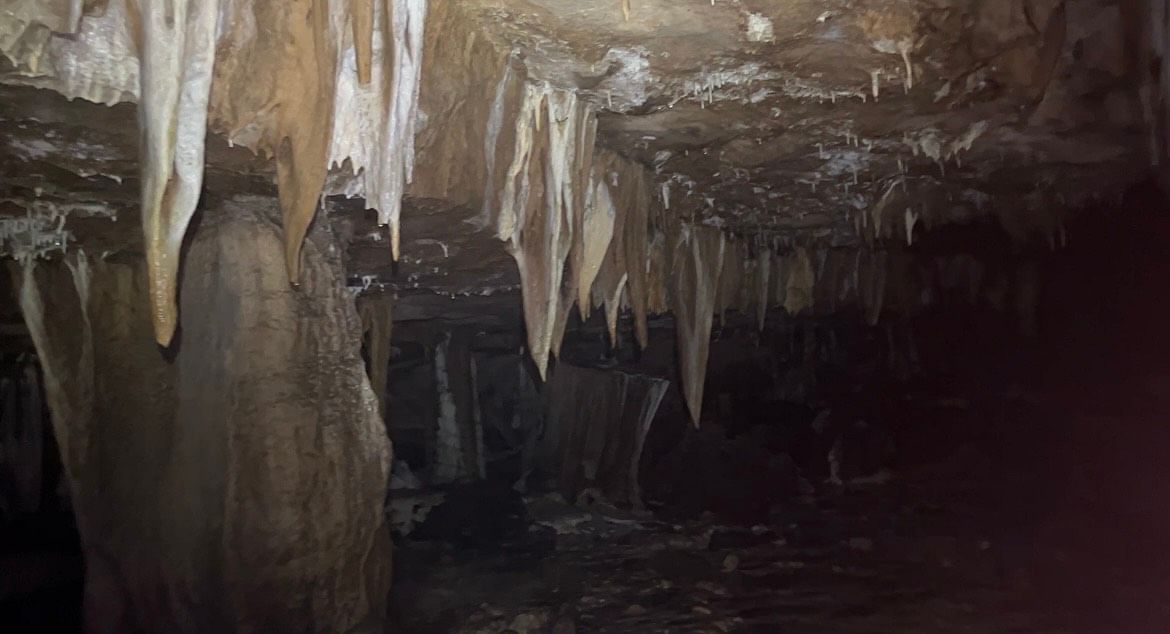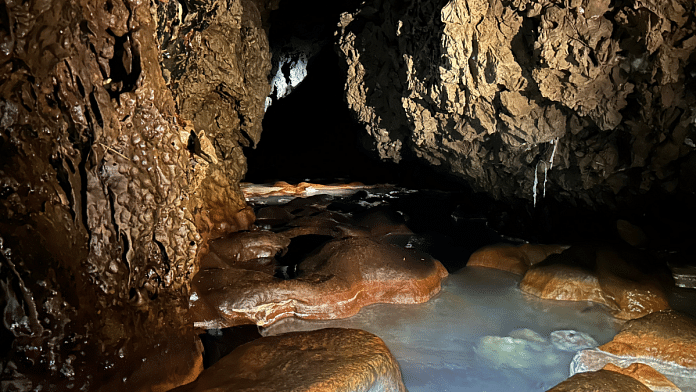Mawmluh/Meghalaya: Meghalaya is called the Abode of the Clouds or Scotland of the East. But the northeastern state isn’t just blessed with breathtaking landscapes; there are natural wonders underneath it too.
The 7.2-km-long rugged and wild Mawmluh Cave, one of the 1,750 registered caves in Meghalaya, is a parallel underground world formed over 4,200 years.
As one reaches deep into the cave after navigating slippery rocks, wading through knee-deep water, crawling on bellies, and crossing a labyrinth of passageways, there exists the spectacular ‘Hanging Garden’ — stalactites or icicle-shaped formations hanging from the cave’s ceiling.

Meghalaya has the highest number of caves in India, including the longest one — the Liat Prah limestone cave system. The state has all the ideal conditions for such formations to thrive: High-grade limestone, rainfall, and elevation, complete with a hot and humid climate. It is thanks to the Meghalaya Adventurers’ Association that most of the caves in the state have been discovered.
“We are discovering not only more caves but master cave systems too,” says Brian D. Kharpran, the 76-year-old founder-secretary of MAA.
In October 2022, Mawmluh Cave was identified as a geological heritage site by the International Union of Geological Sciences, a council that works closely with UNESCO. IUGS came up with a list of 100 geological sites that are “iconic and recognised by the geoscience community for their impact in understanding the Earth and its history”.
It was because of a stalagmite found inside the cave in 2018 that Meghalaya became a part of geological history. The International Commission on Stratigraphy termed the present age in the planet’s 4.54 billion-year history as the ‘Meghalayan Age’.
Also read: Kashmir cricket is 20 yrs behind, says Jasia Akhtar, Delhi Capitals’ pick for women…
Grand old man of caving
Kharpran recalls how he “delved into the dark of the subterranean world of caves” in 1992.
“I didn’t know much about it [then]. I didn’t know that we [the Meghalaya state] had caves — just the few that had been recorded somewhere in books. But I thought there must be caves because we have limestone,” says Kharpran, a former banker. When Kharpran started exploring caves, he had no knowledge about the art of mapping them. There was no National Geographic or Discovery Channel that one could turn to for basic knowledge.
“I borrowed a compass from the Army, and that’s how we started in March 1992,” Kharpran says.
A year later, when he went to explore the cave again, villagers told him about the earlier visits by four British cavers. Kharpran got in touch with Meghalaya’s tourism department to find out about them whom he met in 1994.
“And since 1995, we [have been] organising these caving expeditions in Meghalaya under the ‘Caving in the Abode of the Clouds’ project. These [cavers] from Europe could bring in the equipment and expertise, and here we are 30 years later. We are still exploring caves,” says Kharpran, giving a brief time capsule of the MAA. The group has single-handedly put the state on the world map for cavers.
“The main [objective] is to discover, document, and map caves, describing them in their entirety,” says the remarkably agile founder-secretary, who still goes on the MAA’s annual caving expeditions.
Also read: Pro kabaddi, kho-kho leagues chase IPL viewership. India rediscovering regional sports
From sightseeing to adventure
MAA got the local people in Mawmluh to form a tourism society in 2017. “We trained eight guides. They take tourists inside [the Mawmluh Cave] where all equipment is kept,” Kharpran says. Visitors aren’t allowed to explore the cave without a guide.
“If guides are there, tourists can’t make mischief like break formations,” he adds.
Apart from MAA, Duia Trailblazers is a popular tour agency that offers caving trips with proper equipment and experienced guides. Founder Gerald Samuel Duia says that the adventure activity has picked up, though steadily, in Meghalaya. But he adds that most tourists are unaware of caving as a sport and its technicalities, while some are just afraid of the dark and subterranean world.
“Caving is not for the faint-hearted. There is more to it than entering a cave. It’s about learning the history, observing the formations and the cave system. Another aspect of caving is the protection of these beautiful treasures in the subterranean world,” Duia says.
Tour operator Explore Meghalaya notes that there has been a shift in the interest of travellers arriving in the state. “[In the] last few years, tourism in Meghalaya has changed a lot,” says Dappura Chyne, the founder. While tourists earlier weren’t much into adventure sports in the state, now they seek thrill.
“MMA has also played an important role by exploring the natural caves in Meghalaya. It opened the door for adventure seekers. Caves are being explored, and when they are sure it’s safe, they open it for the tourists,” he adds.
Beautification, mining concerns
In July 2022, a musical show “Ki Sur Na Pubon” (message from the cave) was organised by the state tourism department inside Cherrapunji’s Arwah Cave at Sohra. Throughout the year, the cave, famous for its fossils, is illuminated with interior lights fitted on its ceiling to attract tourists. One can even see crustacean shells and fish skeletons fossilised in the limestone walls of the cave. The tourism department describes the entrance to the Arwah Cave as “straight out of the Arabian Nights”.
However, not everyone is happy with the makeover.
“The idea of visiting a cave is that you are going inside a dark place. You don’t want to see lights on the ceiling,” Kharpran says, insisting that there is a proper way of adorning ‘show caves’. Called ‘commercial caves’ in the United States, a show cave is any cavern that is open to the public for guided visits.
The MAA has a different way of doing things. They leave the cave formations intact, and tourists are taken into wild surroundings. Those interested in exploring the cave further are provided with equipment. “You get the feel of being a caver with lights and boots,” the MAA founder said.
Close to the Mawmluh Cave stands the Mawmluh Cherra Cements Limited (MCCL) plant. The cement firm is the state’s oldest public sector undertaking that now lies dormant due to losses. Efforts, though, are on to revive the plant.
In Meghalaya, illegal mining, especially of coal, has been a concern since decades. Now it has increased and is threatening cave formation.
“The greatest fear [among cavers] is mining…of limestone and coal. Invariably, where you have limestone, you will always find coal. Unfortunately, in Meghalaya, both are going on. They will simply destroy the caves,” Kharpran laments. He says that last year, four caves in Meghalaya — Krem Malo, Krem Umkseh, Krem Umkhang-Kharasniang and Krem Umlawan — were completely destroyed due to limestone mining activities.
Growing interest and dangers
Interest in caving has picked up with the advent of social media. Tour guide Ferdinand Khongtim, 27, was trained by the MAA and started conducting cave tours in 2018. He says that YouTubers are coming to explore caves for content. The number of visitors has also increased since the IUGS put Mawmluh Cave on its list last year.
“We can do a maximum of four tours a week. During the holiday season (November-January), we can have five caving expeditions every day,” he explains. Each expedition comprises 20 visitors.
Amid the spike in interest, Kharpran has a word of caution. “We have to be very careful because people will just go into any cave. What will happen in the case of accidents?” He calls for better government regulations to prevent people from randomly walking into wild caves, which have no enclosures around them.
Gerald of Duia Trailblazers shared similar thoughts on keeping the “caves pristine” and avoiding unfortunate incidents such as the 2009 Nutty Putty cave tragedy in the US and the 2018 Tham Luang cave rescue in Thailand.
“I wouldn’t want the pristine caves to be advertised massively. The cave has its own ecosystem, fauna, and various living species. If people start going to these caves [in large numbers], it will definitely affect the system and will become polluted,” Gerald warns.
Cave tourism is often a tightrope between exploring nature and protecting it. In fact, Kharpran says he stays away from the commercial aspect of caving and is interested in its exploration and scientific side.
The MAA has mapped 531 km of total cave passage in Meghalaya so far. For a small state, that’s a big number. He expects the figure to reach 1,000 km.
“There is the beauty of the unknown, the darkness. You don’t know what you’re going to find in the form of cave life. And here you see the process of evolution,” Kharpran says with a smile.
(Edited by Humra Laeeq)



